Is it too soon to start thinking of the inevitable heat that will be blasting it’s way into our gardens before we know it? I personally don’t think so. Our advice at the stores is to think and prep a season ahead for the best success; summer is up next. This spring has us grabbing up annuals and perennials quicker than ever. What I want to do today is remind you that while spring annuals and perennials are gorgeous indeed, they will inevitably start to shut down their blooms once the heat rolls in. When your spring annuals melt out and your spring perennials say adieu until next year, the options in the following list of heat-loving annuals and perennials will keep you in color through the summer. If you see any of these selections this spring at the nursery, don’t pass them up this year as nursery stock has been limited. (Please note that this list does not necessarily reflect current inventory of annuals and perennials at the nurseries; they are suggestions of items to look for when you visit.)
Annuals for the San Antonio Heat
Angelonia: There is a reason why these dainty beauties are nicknamed, “the summer snapdragon”. With multiple, slender stems that are covered in dainty blooms up and down the length, angelonia provides color in your gardens or container arrangements through the heat of summer. It grows to a perfect height of 18-30 inches tall and spreads with a nice, upright, shrub appearance. Expect these spikes to bloom for you from summer through fall. It’s best to treat these as annuals and plan on replanting them every year. Look for angelonia in colors of purple, pinks, white, lavender, and rose.
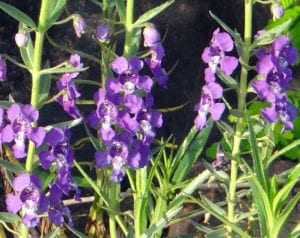

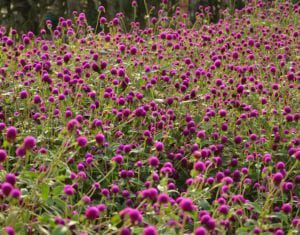

Gomphrena: Gomphrena has always been on my list for favorite heat-loving annuals. I’ve always thought that the bright, deeply-magenta flowers look like something you would see in a Dr. Seuss book, like a miniature version of the trees in The Lorax. The most common variety of these annuals, ‘Buddy’ gomphrena only grow to about 12-18 inches and should be planted about 8 inches apart for the spread. If you are lucky enough to find some of the other unique varieties of gomphrena like: ‘Fireworks’ (a great pollinator attractor), or Qis (fiery red blooms) you should grab them up. I can almost guarantee you won’t be disappointed. These papery little globular flowers can take the heat and keep blooming all summer long. They are also wonderful in dried arrangements. You will need to replant these annuals each year, but once you try them, you always search them out to add to your spring and summer garden purchases.
Purslane: One of our best, true, heat-loving annuals is purslane. These annuals are a “sure thing” for seeing you through the summer with an abundance of vivid colors in “hot” hues like: flaming fuchsia, lemon yellow, cotton candy pink, and mandarin orange. Purslane doesn’t take much care to thrive. They can even grow in poorer soils, you just need to make sure that it is planted in a well-draining area, in full sun, and watered only when needed. These low-growing annuals make excellent hanging baskets with their wide spreading/cascading habit. Bonus: They are edible!
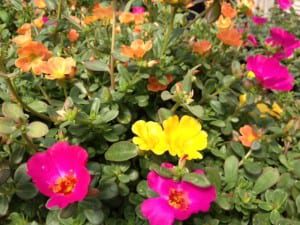

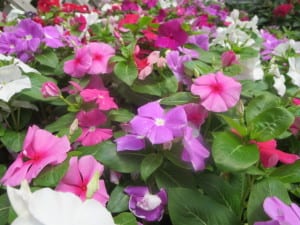

Vinca: Vinca or periwinkle are another of our heat-loving favorite annuals. They are among the most heat tolerant of all southern bedding plants which is why you see them everywhere late spring to fall. They look positively stunning when planted in masses. The flowers grow only about 12 -18 inches tall (shorter for cascading varieties) so they make a perfect border specimen, and container plants. Give vinca at least 6 hours of direct sunlight for good development. Bright flowers in shades of pink, red, white, and lavender adorn the bright green foliage all summer long. Shear back when stems become leggy to rejuvenate them into fuller, bushier annuals with more blooms.
If the options above are not enough to entice you, you can also look for: celosia, zinnia, pentas, fanflower, gaillardia, copper plants, and alternantheras. For shade garden options you might be interested in: coleus, caladiums, Persian shield, perillas, and both wax and Dragon Wing begonias
Perennials for San Antonio Heat
Tropical Milkweed: There are many reasons we love the tropical milkweed plant. For one, the bright orange, yellow, and red colors of the flower gives us the brilliant and vibrant hues we crave to see during the summertime. For two, it is one of the best butterfly attracting plants out there. Not many people would say they don’t want butterflies visiting their yards. The sight of these fluttering creatures can make us want to toss aside whatever we are doing at the moment and chase after them as we did in our childhood days. Tropical milkweed can be planted further back in your sunny, perennial gardens as it can reach 4-5 feet high. These perennials need to be cut back to the ground after each fall butterfly migration; they will return to your garden in spring when the weather begins to warm again.
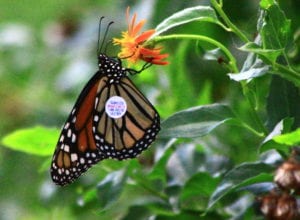

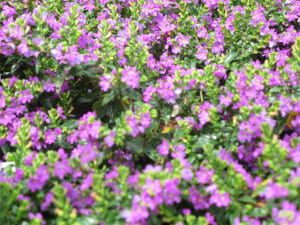

Mexican Heather: A favorite early-bloomer that doesn’t quit flowering until the first hard frost, Mexican heather are great xeriscape perennials. These 8 inch tall plants are stay full and compact through the season, and can be pruned after winter to start their cycle all over again. They make ideal flowerbed borders, especially when planted in mass. They also look great in hanging baskets or in other container gardens. While these perennials look best with regular water, Mexican heather can withstand short periods of drought without a problem. They are great pollinator-attracting perennials, and are not usually bothered by pests or disease. Add a few between the rows of your vegetable gardens to increase pollination. Plant in morning-early afternoon sun and late afternoon shade is great for these perennials. Enjoy the tiny but profuse purple, pink, or white flowers that pepper the plant’s dark-green foliage. Mexican heather will return regularly after mild winters.
Bat Face Cuphea: This cuphea is one of the cutest perennials on this list. Not only does it bloom profusely throughout the summer, the blooms have the most adorable resemblance to a tiny, fuzzy, bat face. The “bat face” alone is reason enough to love this plant, but its easy care is an added bonus. These perennials are tough plants that reach about 18 inches tall, growing with an open and sprawling habit. Hummingbirds love the vivid red hue that tops a deep purple center. Plant in full sun and don’t worry about the heat. If the winter isn’t too cold, it will return in spring after dying down to the roots. (Cigar plant is another cuphea tht shines during the heat.)
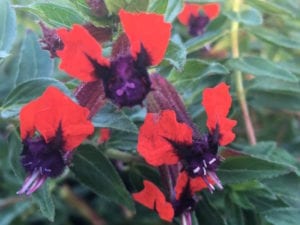

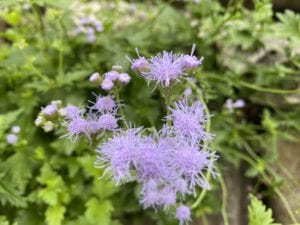

Gregg’s Blue Mistflower: Fuzzy, powder blue blooms perched ontop of a sprawling bed of chartreuse-green foliage creates a nectar-filled patch that has Queen butterflies (and others) visiting these perennials often. Blue mistflower spreads by roots underground, so make sure you have space for this plant. Personally, I want all the butterflies I can get so I let it go where it wants to go. (Containers are an option too!) It’s super easy to take a sharpshooter and cut out patches of these perennials that grow out of bounds, OR to use as new transplants for even more patches in your landscape. Full sun to part shade in well-draining area is best.
Other perennials and sub-tropical perennials will also offer some of the most amazing summer color. Look for: Purple coneflower, Blackfoot daisy, gaura, gingers, cannas, Pride of Barbados, esperanza, firecracker fern, red hot poker, bougainvillea, and shrimp plant.
If you’ve ever been to visit Rainbow Gardens, you know that this list is just an inkling of what you can try, but my hope is that you’ll realize you have many options for summer color. Come take a walk through the nurseries and check out each and every bloom, I know they are looking forward to seeing you.
~The Happy Gardener, Lisa Mulroy


Do you have yellow plumbago?
Hi Cheryl,
If you mean Thryallis, also known as yellow plumbago, both of our locations have a few in stock as of today, can’t promise what the stock will be in the next couple of days as our inventory has been moving very quickly. Thousand Oaks has about nine 1 gallon at $11.99 each, and eleven 3 gallons at $32.99. Our Bandera location has about eleven 3 gallons at $21.99. Hope this helps.
Do y’all have vincas at your Bandera road location?
Not yet. We hopefully will be getting some there soon. Thousand Oaks has them now. Thursdays are a great time to check at the store as most of our trucks have come in for the week.
Can yall give me prices for large pots
Hi Veronica,
We have a huge supply of pottery and containers, and we don’t currently have a master list as our inventory changes daily. Pot prices have a huge range and since we don’t know what type you are specifically looking for, it will be difficult to give you prices. We carry Asian glazed pottery, terracotta, plastic pots, coconut lined pots and baskets, etc… without knowing how large, what type, etc… I can’t hone in on prices.
Come visit us and see our selections, we’d love to see you here!
When will Bat Face Cuphea’s be in stock?
Hi Shelley,
Both locations currently have some 1 galon Bat Face Cuphea in stock, as of today. Plant material is moving fast this year, so if you plan to visit later in the week, best to call the location you are going to visit to make sure it is still in stock.
do peonies grow here?
Hi Ruth,
No they do not. Our winters just generally don’t get cold enough for their needs. I’m attaching a link to an interesting article explaining why some plants just can’t be grown here (peonies are mentioned in it). Want to Grow the Forbidden Fruits.
We have early morning sun and then afternoon is completely south…obviously very hot and dry in the summer. And still sun going into early sunset. What can I grown that has pretty flowers? I am from the east coast and so used to their afternoon sun and soil. I’m spending a fortune trying to figure what is best. Our roses are definitely beautiful during that hot sun. How will potted Bougainvilleas do. Our neighbor had them planted ingrown in Hawaii and the thorns are absolutely “murder”! Hanging potted for me is the only way .
Thank in advance for the help.
Hi Carol,
I’ll offer a few plants to consider, but keep in mind I don’t know how much room you have to grow things, so do a little research on these plants to see if they’ll fit in your area. Bougainvilleas will do great in those full sun areas, but yes, their thorns are no joke!
*Larger sub-perennials: Pride of Barbados, Gold Star Esperanza
*Perennials: Lantana (we like Texas variety as it is native and non invasive, and New Gold and Trailing lantana, but all work), Verbena, Firecracker Fern, Pavonia Rock Rose
*Annuals: Cora series Vinca (periwinkle) both standard and trailing, zinnia, Purslane and Moss rose, Angelonia (a personal favorite, also called the summer snapdragon, very showy), Gomphrena.
* Tropical hibiscus love full sun too.
Maybe something on these lists will be to your liking.
Do you have Mexican Heather?
Lantana?
Hi Ralph,
Yes we do, as of today 4/25/2023.